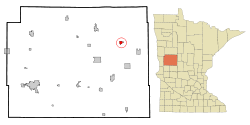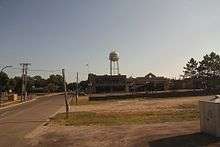New York Mills, Minnesota
New York Mills is a city in Otter Tail County, Minnesota, United States. The population was 1,199 at the 2010 census.[5]
New York Mills | |
|---|---|
 Downtown New York Mills | |
| Motto(s): "Small Town, Big Life." | |
 Location of New York Mills, Minnesota | |
| Coordinates: 46°31′10″N 95°22′23″W | |
| Country | United States |
| State | Minnesota |
| County | Otter Tail |
| Area | |
| • Total | 1.46 sq mi (3.77 km2) |
| • Land | 1.45 sq mi (3.76 km2) |
| • Water | 0.00 sq mi (0.01 km2) |
| Elevation | 1,411 ft (430 m) |
| Population | |
| • Total | 1,199 |
| • Estimate (2019)[3] | 1,223 |
| • Density | 841.71/sq mi (325.08/km2) |
| Time zone | UTC-6 (Central (CST)) |
| • Summer (DST) | UTC-5 (CDT) |
| ZIP code | 56567 |
| Area code(s) | 218 |
| FIPS code | 27-46060 |
| GNIS feature ID | 0648524[4] |
| Website | City of New York Mills |
History

New York Mills was platted in 1883.[6] The city was originally built up chiefly by Finns.[7]
Geography
According to the United States Census Bureau, the city has a total area of 1.30 square miles (3.37 km2), all of it land.[8]
Transportation
U.S. Route 10 serves as a main route in the city.
Demographics
| Historical population | |||
|---|---|---|---|
| Census | Pop. | %± | |
| 1890 | 260 | — | |
| 1900 | 353 | 35.8% | |
| 1910 | 474 | 34.3% | |
| 1920 | 700 | 47.7% | |
| 1930 | 667 | −4.7% | |
| 1940 | 771 | 15.6% | |
| 1950 | 977 | 26.7% | |
| 1960 | 828 | −15.3% | |
| 1970 | 791 | −4.5% | |
| 1980 | 972 | 22.9% | |
| 1990 | 940 | −3.3% | |
| 2000 | 1,158 | 23.2% | |
| 2010 | 1,199 | 3.5% | |
| Est. 2019 | 1,223 | [3] | 2.0% |
| U.S. Decennial Census[9] | |||
2010 census
As of the census[2] of 2010, there were 1,199 people, 533 households, and 287 families living in the city. The population density was 922.3 inhabitants per square mile (356.1/km2). There were 602 housing units at an average density of 463.1 per square mile (178.8/km2). The racial makeup of the city was 94.8% White, 0.3% African American, 1.8% Native American, 0.3% from other races, and 2.8% from two or more races. Hispanic or Latino of any race were 1.8% of the population.
There were 533 households, of which 27.4% had children under the age of 18 living with them, 39.4% were married couples living together, 10.7% had a female householder with no husband present, 3.8% had a male householder with no wife present, and 46.2% were non-families. 40.0% of all households were made up of individuals, and 22.1% had someone living alone who was 65 years of age or older. The average household size was 2.12 and the average family size was 2.84.
The median age in the city was 38.9 years. 23.9% of residents were under the age of 18; 9% were between the ages of 18 and 24; 22% were from 25 to 44; 22.6% were from 45 to 64; and 22.5% were 65 years of age or older. The gender makeup of the city was 46.0% male and 54.0% female.
2000 census
As of the 2000 census, there were 1,158 people, 492 households, and 276 families living in the city. The population density was 926.7 people per square mile (357.7/km2). There were 535 housing units at an average density of 428.1 per square mile (165.3/km2). The racial makeup of the city was 98.53% White, 0.09% African American, 0.35% Native American, 0.17% from other races, and 0.86% from two or more races. Hispanic or Latino of any race were 1.30% of the population. 27.4% were of German, 25.5% Finnish, 13.5% Norwegian, and 5.4% Swedish ancestry.
There were 492 households, out of which 27.8% had children under the age of 18 living with them, 42.5% were married couples living together, 9.6% had a female householder with no husband present, and 43.9% were non-families. 40.0% of all households were made up of individuals, and 27.8% had someone living alone who was 65 years of age or older. The average household size was 2.18 and the average family size was 2.92.
In the city, the population was spread out, with 22.5% under the age of 18, 8.7% from 18 to 24, 20.6% from 25 to 44, 16.5% from 45 to 64, and 31.7% who were 65 years of age or older. The median age was 43 years. For every 100 females, there were 82.6 males. For every 100 females age 18 and over, there were 79.2 males.
The median income for a household in the city was $27,596, and the median income for a family was $35,536. Males had a median income of $29,286 versus $18,333 for females. The per capita income for the city was $15,949. About 11.7% of families and 17.1% of the population were below the poverty line, including 21.7% of those under age 18 and 19.0% of those age 65 or over.
Arts and economic development
The city of New York Mills was founded in 1884 by Finnish immigrants. Major industries include agriculture (row crops, grain and dairy farming), Lund Boat Company fishing boat manufacturers, and a variety of service professions. Located in Otter Tail County, which contains 1,048 of the state's lakes, tourism is an increasingly important economic factor in the area.

New York Mills Regional Cultural Center
Faced with the economic challenges and decreasing population of many rural communities, New York Mills decided to invest in a Regional Arts Center in an attempt to bring tourism to the area. In 1991 the city contributed $35,000 to the Regional Arts Retreat and Cultural Center to convert a downtown mercantile building into a multi-use arts and cultural facility. As a per-capita investment, this expenditure would be the equivalent of Minneapolis giving $13.7 million to an arts facility. The center, remodeled through a community-wide volunteer effort, opened its doors in June, 1992, as a non-profit Arts organization founded by John Davis. Further renovations include a new hardwood maple floor in the main gallery and an outdoor deck completed in 2005. While other communities withered in the face of declining populations and deteriorating main streets, New York Mills has remained stable economically, while the Cultural Center continues to draw people, activity, revenue and national attention to the community.[10]
Mission statement
"The NYMRCC is dedicated to expanding the cultural and creative opportunities of rural Americans by offering innovative, quality arts programming, and demonstrating how the arts can be used as an economic development tool in rural communities across the nation."
Programs
- Artist-In-Residence Program
- Education/Outreach programs
- Gallery Exhibits
- “Great American Think-Off” Annual Philosophical Debate
- Literary and Theater Events
- Music Concert Series
- Sculpture Park
Past exhibiting artists
- Robin Barcus Slonina
- Charles Beck
- Betsy Bowen
- Duane & Bambi Goodwin
- Eric Johnson
- Kent Kapplinger
- Maxwell MacKenzie
- David Salmela
Notable people
- Peter Hayes (born 1976), indie rock guitarist and singer
- Janet Karvonen, pioneer for girls' basketball
See also
References
- "2019 U.S. Gazetteer Files". United States Census Bureau. Retrieved July 26, 2020.
- "U.S. Census website". United States Census Bureau. Retrieved 2012-11-13.
- "Population and Housing Unit Estimates". United States Census Bureau. May 24, 2020. Retrieved May 27, 2020.
- "US Board on Geographic Names". United States Geological Survey. 2007-10-25. Retrieved 2008-01-31.
- "2010 Census Redistricting Data (Public Law 94-171) Summary File". American FactFinder. U.S. Census Bureau, 2010 Census. Retrieved 23 April 2011.
- Upham, Warren (1920). Minnesota Geographic Names: Their Origin and Historic Significance. Minnesota Historical Society. p. 396.
- Winser, Henry Jacob; Riley, William C. (1897). The Official Northern Pacific Railway Guide: For the Use of Tourists and Travelers Over the Lines of the Northern Pacific Railway and Its Branches. Northern Pacific Railway. p. 54.
- "US Gazetteer files 2010". United States Census Bureau. Archived from the original on 2012-01-25. Retrieved 2012-11-13.
- United States Census Bureau. "Census of Population and Housing". Retrieved September 10, 2013.
- Cunningham, Laine (November 19, 2000). "Culture Rules in New York Mills". American Profile. Retrieved 12 July 2017.
